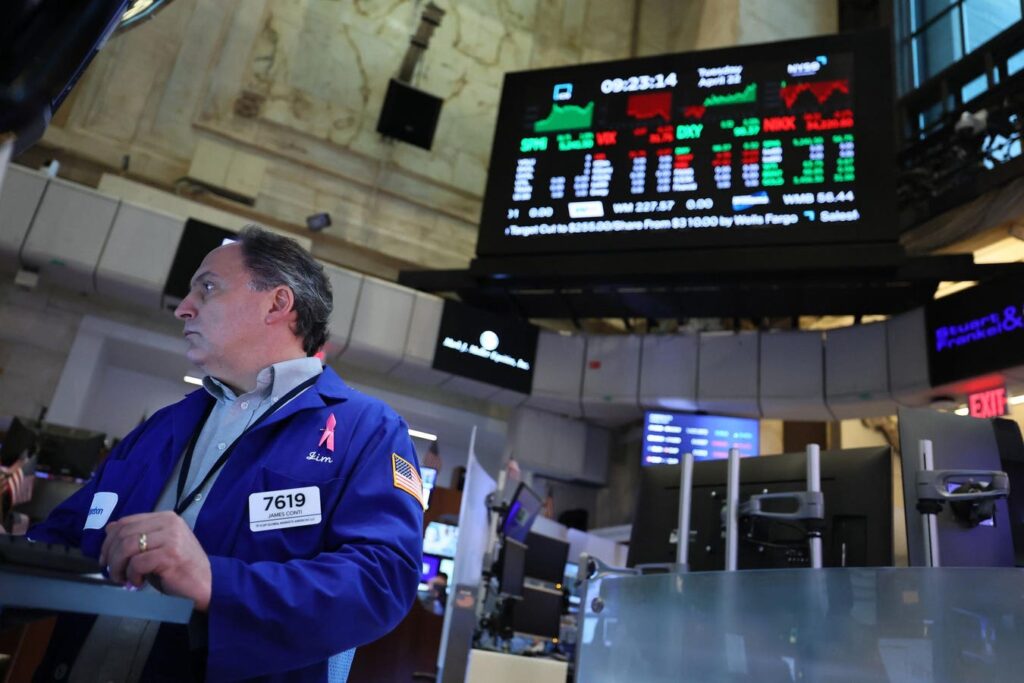Washington’s borrowing spree just got a lot more expensive. Bond markets are signaling distress with 30-year borrowing rates spiking to 5%. The moment is here. Moody’s has officially downgraded U.S. sovereign debt, citing rising fiscal deficits, political dysfunction, and unsustainable debt dynamics.
The U.S. must refinance trillions in maturing debt over the next few years, and that debt will now roll over at sharply higher interest rates. And if history is any guide, the ripple effects could be swift and sweeping. [1] A downgrade combined with, [2] foreign investors’ already low confidence in the Trump administration’s unpredictable economic actions would imply dwindling demand for U.S. treasuries – no longer considered the safest. Specifically, foreign funds withdrew an estimated $14.2 billion from U.S. Treasuries and corporate bonds just in the two weeks ending April 16.
But the buck doesn’t stop there. The broader market is at risk as bond yields spike.
It’s not going to happen overnight but eventually, the decline could wipe out trillions in market capitalization. Our dashboard How Low Can Stocks Go During A Market Crash captures how key stocks fared during and after the last seven market crashes. Giants like Nvidia can drop even more.
However, we adopt a macro-conscious approach in our High-Quality portfolio, incorporating smart money rotation based on changing market regimes. HQ has outperformed the S&P 500 and achieved returns greater than 91% since inception. Separately, see Google’s $1 Trillion Lawsuit.
Here is how the S&P 500 is at a risk of steep drawdown.
Bonds Compete With Equity Capital
Sure, foreign bond investors may see U.S. treasuries as more risky – but equity investors already take a lot more risk. For them, as yields climb, Bonds become more attractive, drawing capital away from stocks. Capital shift can lead to large scale sell offs that could send the market crashing down. Just look at the history:
- Early 1980s: Treasury yields spiked to > 15% as Fed raised rates to combat double-digit inflation. The result? Stocks lagged and bonds became massively attractive
- 2000 Dot-com Bubble: Bond yields remained reasonably high but investors fled to Bonds only when the bubble burst. Treasuries rallied and Nasdaq had one of the worst crashes in recent decades.
Higher Yields Create a Toxic Mix for Stocks
The knock-on effects of elevated yields are dangerous for equities:
- Valuation Compression: Capital to finance businesses becomes more expensive. The result? The discount rate applied to future corporate earnings increases – leading to lower present valuations – especially for high-growth tech stocks that dominate the S&P 500.
- Corporate Margin Squeeze: Companies with high debt loads face surging interest costs, eroding free cash flow and weakening earnings. This especially hits leveraged sectors like real estate.
- Investor Reallocation: As yields rise, investors shift out of equities and into fixed-income assets, now offering attractive risk-adjusted returns. That rotation itself depresses stock prices further.
Capital Flight Risk
A downgrade also chips away at the “risk-free” perception of U.S. Treasuries. If global investors – especially foreign central banks – begin to question the creditworthiness of the U.S. assets, we could see:
- Outflows from Treasuries, pushing yields even higher.
- Dollar depreciation, as capital seeks safer or more stable alternatives.
- Large selloffs in U.S. equities, triggered by both sentiment shifts and forced portfolio rebalancing.
Such capital flight could compound volatility, particularly in an already fragile macro environment. Dollar depreciation, especially if accompanied by increase in inflation expectations because imports now become more expensive, could further add to the problem.
The Fed’s Dilemma: Monetize or Tighten?
If yields spike beyond acceptable levels, the Federal Reserve may be forced to intervene – buying Treasuries to stabilize markets. That means:
- Injecting liquidity into the system when inflation is still not fully under control.
- Fueling fears of long-term inflation, which further undermines bond and equity market stability.
- Losing monetary independence, as fiscal dominance takes hold – where the Fed is forced to enable government borrowing regardless of inflation risks.
What If the U.S. Defaults?
A technical default – say, from a debt ceiling standoff – would be catastrophic. Even a short-lived failure to pay bondholders on time could:
- Spark a freeze in money markets and a spike in credit default swaps.
- Trigger a selloff in Treasuries, pushing yields to unsustainable levels.
- Cause a 30–50% drawdown in the S&P 500, as systemic risk re-enters the conversation. See how the S&P has fallen during last several market crashes
The Worrisome Macro Picture
The economy is in a more fragile state than it was more than a decade ago.
- The U.S. national debt figure currently stands at $36.2 trillion. That’s a whopping 124% of the country’s GDP. In 2011, the debt figure was less than half the current figure at $14.8 trillion – roughly 95% of U.S. GDP.
- The fed funds rate is currently at 4.3% as the Federal Reserve tries to ensure a “soft landing” for the U.S. economy after inflation swelled to over 9% in mid-2022. While the current fed rate is better than the level of over 5% maintained over most of 2023 and 2024, the figure was near 0% in 2011 in response to the 2008 recession.
- The higher debt figure combined with higher interest rates mean that the U.S. is spending much more to service its debt. Nearly four times more. The country shelled out $230 billion in interest payments in 2011 and will be paying $952 billion in interest over 2025.
Put simply: the U.S. is a lot more indebted today than it was in 2011, and servicing that debt is a lot more expensive. And that could spread to the private sector as well. See This $1.8 Trillion Debt Bomb Will Flip Corporate America’s Playbook
The Chain Reaction
The Moody’s downgrade is not the cause of the crisis – it’s a reflection of deeper structural imbalances. But it could be the trigger that sets off a chain reaction.
Trillions in refinancing -> Soaring yields -> Fed intervention -> Inflation fears -> Capital flight -> Equity revaluation.
Investors don’t like uncertainty. They don’t like risk – definitely not these high levels of risk. The Trefis High Quality (HQ) Portfolio, that roots itself in quality that seeks reliability, predictability and compounding growth, is an option you can explore. With a collection of 30 stocks, it has a track record of comfortably outperforming the S&P 500 over the last 4-year period. Why is that? As a group, HQ Portfolio stocks provided better returns with less risk versus the benchmark index; less of a roller-coaster ride as evident in HQ Portfolio performance metrics.
Counterpoint: Why The Crash May Not Materialize
While the risks are real, a full-blown crash isn’t guaranteed. The U.S. still retains key advantages: (a) the world’s reserve currency, (2) deep and liquid capital markets, and (3) a resilient, innovation-driven economy.
The Federal Reserve has shown it can act decisively in times of stress. The trade-tensions sparked by tariffs are already easing, and the market bounce-back reflects that.
Moreover, global alternatives remain limited – making U.S. assets, even at higher yields, relatively attractive. If inflation remains contained and growth holds up, markets could digest higher rates without unraveling. In this more benign scenario, the Moody’s downgrade becomes a wake-up call – not a trigger for collapse.
Read the full article here
















